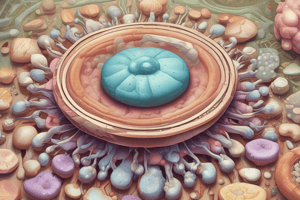Podcast
Questions and Answers
What is the primary classification of antifungal drugs that includes amphotericin B?
What is the primary classification of antifungal drugs that includes amphotericin B?
- Allylamine drugs
- Polyene antibiotics (correct)
- Azole derivatives
- Echinocandin drugs
What type of fungal infections involves infections of nails, skin, and mucous membranes?
What type of fungal infections involves infections of nails, skin, and mucous membranes?
- Subcutaneous mycoses
- Cutaneous mycoses
- Superficial mycoses (correct)
- Systemic mycoses
What is the term for a dermatophyte infection of the nails?
What is the term for a dermatophyte infection of the nails?
- Onychomycosis (correct)
- Tinea pedis
- Tinea cruris
- Tinea corporis
Which of the following is NOT a type of fungal infection?
Which of the following is NOT a type of fungal infection?
What is the term for a dermatophyte infection of the body?
What is the term for a dermatophyte infection of the body?
Which of the following antifungal drugs is NOT an azole derivative?
Which of the following antifungal drugs is NOT an azole derivative?
What is the term for the fungal infection caused by Blastomyces dermatitidis?
What is the term for the fungal infection caused by Blastomyces dermatitidis?
What is the term for a fungal infection of the groin area?
What is the term for a fungal infection of the groin area?
Which of the following is a causative agent of superficial yeast infections?
Which of the following is a causative agent of superficial yeast infections?
Which of the following is NOT an example of a subcutaneous mycosis?
Which of the following is NOT an example of a subcutaneous mycosis?
What is the term for the fungal disease caused by Coccidioides immitis or Coccidioides posadasii?
What is the term for the fungal disease caused by Coccidioides immitis or Coccidioides posadasii?
What is the classic triad of symptoms for Coccidioidomycosis?
What is the classic triad of symptoms for Coccidioidomycosis?
What type of mycosis is often caused by puncture wounds contaminated with soil fungi?
What type of mycosis is often caused by puncture wounds contaminated with soil fungi?
What type of mycosis is characterized by a chronic and indolent course?
What type of mycosis is characterized by a chronic and indolent course?
Which of the following fungi causes tinea versicolor?
Which of the following fungi causes tinea versicolor?
What is the term for the fungal infection that causes skin lesions and lytic bony lesions?
What is the term for the fungal infection that causes skin lesions and lytic bony lesions?
What is theprimary organ affected by Histoplasmosis?
What is theprimary organ affected by Histoplasmosis?
What is the most common form of Aspergillosis?
What is the most common form of Aspergillosis?
What is the defining opportunistic infection for AIDs?
What is the defining opportunistic infection for AIDs?
What is characteristic of Mucormycosis?
What is characteristic of Mucormycosis?
What is typically used to treat severe mycoses?
What is typically used to treat severe mycoses?
What is the limitation of Amphotericin B?
What is the limitation of Amphotericin B?
What is the purpose of adding Flucytosine to Amphotericin B?
What is the purpose of adding Flucytosine to Amphotericin B?
What is the half-life of Amphotericin B?
What is the half-life of Amphotericin B?
Which antifungal drug is effective against esophageal, oropharyngeal, and invasive candidiasis?
Which antifungal drug is effective against esophageal, oropharyngeal, and invasive candidiasis?
What is the mechanism of action of Flucytosine?
What is the mechanism of action of Flucytosine?
Why is Griseofulvin not effective against Candida?
Why is Griseofulvin not effective against Candida?
What is the benefit of taking Griseofulvin with a high-fat meal?
What is the benefit of taking Griseofulvin with a high-fat meal?
What is the fate of infected cells in the body after treatment with Griseofulvin?
What is the fate of infected cells in the body after treatment with Griseofulvin?
What is the main site of metabolism of Griseofulvin?
What is the main site of metabolism of Griseofulvin?
What type of infection is Griseofulvin commonly used to treat?
What type of infection is Griseofulvin commonly used to treat?
Where is Griseofulvin deposited in the body?
Where is Griseofulvin deposited in the body?
What percentage of people who receive Amphotericin B experience some degree of renal toxicity?
What percentage of people who receive Amphotericin B experience some degree of renal toxicity?
Which of the following antifungal medications has the highest oral bioavailability?
Which of the following antifungal medications has the highest oral bioavailability?
Which azole derivative is particularly useful in the treatment of blastomycosis and histoplasmosis?
Which azole derivative is particularly useful in the treatment of blastomycosis and histoplasmosis?
Which of the following antifungal medications does not penetrate the cerebrospinal fluid (CSF)?
Which of the following antifungal medications does not penetrate the cerebrospinal fluid (CSF)?
What is the primary route of elimination for Fluconazole?
What is the primary route of elimination for Fluconazole?
Which of the following antifungal medications is available in PO and topical formulations, including shampoo?
Which of the following antifungal medications is available in PO and topical formulations, including shampoo?
What is the primary use of Caspofungin?
What is the primary use of Caspofungin?
What is a common adverse effect of systemic administration of azole derivatives?
What is a common adverse effect of systemic administration of azole derivatives?
Flashcards are hidden until you start studying
Study Notes
Antifungal Drugs
- Classification of antifungal drugs:
- Polyene antibiotics (e.g., amphotericin B)
- Azole derivatives (e.g., clotrimazole, fluconazole)
- Allylamine drugs (e.g., terbinafine)
- Echinocandin drugs (e.g., caspofungin)
- Other antifungal agents
Fungal Infections
- Divided into three main groups:
- Systemic mycoses (e.g., soft tissue infections, UTIs, PNA, meningitis, septicemia)
- Subcutaneous mycoses (e.g., sporotrichosis)
- Superficial mycoses (e.g., infections of nails, skin, and mucous membranes caused by dermatophytes and yeasts)
Superficial Dermatophyte Infections
- Causative agents: Epidermophyton, Microsporum, and Trichophyton spp.
- Typically manifest as a rash with pruritus and erythema
- Ringworm presents as an annular, scaly rash with a clear center
- Terms for dermatophyte infections:
- Onychomycosis (tinea unguium): dermatophyte infection of nails
- Tinea pedis: athlete's foot
- Tinea corporis: ringworm of the body
- Tinea cruris: jock itch
Superficial Yeast Infections
- Causative agents: Candida spp. (usually C. albicans)
- Present as oral candidiasis (thrush), vulvovaginal candidiasis, or candidiasis infections of axilla, groin, or gluteal folds (diaper rash)
- Less common causes: M. furfur and M. ovalis
- M. furfur causes tinea versicolor (also called pityriasis versicolor)
- Both yeasts cause seborrheic dermatitis
Subcutaneous Mycoses
- Often caused by puncture wounds contaminated with soil fungi
- Examples: chromomycosis, pseudallescheriasis, and sporotrichosis
Systemic Mycosis
- Chronic and indolent (e.g., blastomycosis, coccidioidomycosis, histoplasmosis)
- Invasive and life-threatening (e.g., aspergillosis, candidiasis, cryptococcosis, mucormycosis)
Blastomycosis
- Fungal infection caused by Blastomyces dermatitidis
- Endemic to North America
- Clinical symptoms similar to histoplasmosis
- Flu-like illness, acute illness resembling bacterial PNA, chronic illness mimicking TB/lung cancer, fast progressive disease like ARDS, skin lesions, bony lytic lesions
Coccidioidomycosis
- Also known as "valley fever", "California fever", and "San Joaquin Valley fever"
- Fungal disease caused by Coccidioides immitis or C. posadasii
- Endemic in certain parts of Arizona, California, Nevada, New Mexico, Texas, Utah, and northern Mexico
- 60% are asymptomatic, 40% have varied symptoms, including fever, joint pain, and erythema nodosum (classic triad of "desert rheumatism")
Histoplasmosis
- Also known as "cave disease", "spelunker's lung", and "Ohio Valley disease"
- Fungal infection caused by Histoplasma capsulatum
- Found in soil, often associated with decaying bat guano or bird droppings
- Primarily affects lungs, known as disseminated when other organs are affected
- Can be fatal if left untreated
Aspergillosis
- Wide variety of diseases caused by fungi from the genus Aspergillus
- Majority of cases in people with underlying TB or COPD but with otherwise healthy immune systems
- Most common occurances: chronic pulmonary aspergillosis, aspergilloma, or allergic bronchopulmonary aspergillosis
Cryptococcosis
- Potentially fatal fungal disease caused by Cryptococcus neoformans and C. gattii
- Acquired by inhalation of infectious material from the environment; found worldwide in soil
- Defining opportunistic infection for AIDS (but also seen with lymphomas, sarcoid, liver cirrhosis, and patients on long-term steroid therapy)
Mucormycosis
- Any fungal infection caused by fungi in the order Mucorales
- Characterized by hyphae growing in and around blood vessels; potentially life-threatening in diabetic or severely immunocompromised individuals
Treating Fungal Infections
- Amphotericin B typically used to treat severe mycoses
- Azoles used for less severe infections
- New agents (e.g., voriconazole and caspofungin) can be used to treat invasive Candida and Aspergillus infections
- Flucytosine usually given with amphotericin B to treat systemic cryptococcal or Candida infections
Studying That Suits You
Use AI to generate personalized quizzes and flashcards to suit your learning preferences.




